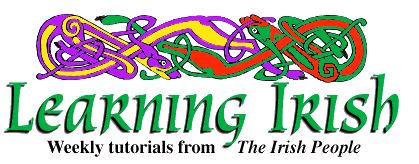
Irish Lesson 7
|
Pronunciation The sounds of the letter "r" in Irish differ from those of the "r" in English. When next to an "a", "o", or "u", the sound is usually rolled. To pronounce this "r", bring the tip of the tongue near the hard ridge behind your upper front teeth and vibrate the tongue as you say the "r". Keep the tongue relaxed. Then try: rá (raw*), rón (rohn), rún (roon). If the "r" begins a word and is followed by "e" or "i", it usually has this broad sound, too, as in: ré (ray*), rí (ree). The rolling or vibration of the tongue is in the front of the mouth, not in the back as in some other European languages. Inside a word, the broad "r" sound may not be rolled or trilled as much as it is at the beginning of a word. A double "r" next to an "a", "o", or "u" is more likely to be rolled, as in: carraig (KAHR-rig). When the "r" is next to an "e" or "i" inside a word or at the end of a word, it gets its slender sound. To make this sound, which is a difficult one for most Americans, place the tongue tip close to the top of your upper teeth and form a shallow pocket or hollow in the tongue tip. Don't make the hollow too deep. Then pronounce "r" by blowing air at the tongue tip and dropping the tongue tip down. Try this several times, and try saying "tír" (teer). Notice how you start with your tongue tip on the hard ridge behind your upper front teeth and then move the tongue tip forward into position for the slender "r". The "r" sound may remind you somewhat of the slender "d" of Lesson 2, but there is a clear difference. Now try: fir (fir), mír (meer). Next, try it beside a consonant: trí (tree), briste (BRISH-te), creid (kred). Work on the "t" and "d" in these words, too. See Lesson 2. For a little more help with this sound, think back to the way in which some Irish persons pronounce the sentence "Where is it?" You may have heard this imitated on radio or television by persons attempting to speak with an Irish accent. The sound is the slender "r" of the Irish language, brought by Irish from their own language into the foreign language of English.
VOCABULARY
Feminine nouns
READING PRACTICE Féach! Tá fear ag teacht isteach. M'athair, is dócha, agus tá mo mháthair ansin, freisin. Nach bhfuil siad fliuch? Tá, go cinnte. (TAW*-mid suh VWAHL-e uh-NISH. neel ay*n DIN-e suh traw*d in-YOO. taw* un EYEM-sheer goh DUHN-uh. taw* shay* FOO-uhr flyuk*, Ah-guhs taw* shay* uh kur BAW*SH-tee. suh tyahk*, taw* un SHOHM-ruh shuh te TIR-im. taw* bohrd suh SHOHM-ruh, AH-guhs bohrd EL-e suh HYISH-tin.) (FAY*-ahk*! taw* far uh tyahk*t ish-TYAHK*. MA-hir, is DOHK*-uh, AH-guhs taw* muh VWAW*-hir un-SHIN, FRESH-in. nahk* vwil SHEE-uhd flyuk*? taw*, goh KIN-te). We are at home now. There is no one in the street today. The weather is bad. It's cold and wet, and it's raining. In the house, this room is warm and dry. There is a table in the room, and another table in the kitchen. Look! A man is coming in. My father, probably, and my mother is there, too. Aren't they wet? They are, indeed. Notes: In Irish, the word "agus" (AH-guhs), and, is often omitted between adjectives starting with the same letter. "Fuar fliuch" and "te tirim" are examples.
CONVERSATION Sheila, here's a newspaper for you. Síle (SHEEL-uh): Nuachtán Éireannach, an ea? (NOO-uhk*-taw*n AY*R-uh-nahk*, un a) An Irish paper, is it? Liam: Ní hea, ach nuachtán Meiriceánach, agus tá ceacht Gaeilge ann (nee ha, ahk* NOO-uhk*-taw*n mer-i-KAW*-nahk*, AH-guhs taw* kyahk*t GAY*lig-e OUN). It is not, it's an American paper, and there's an Irish lesson in it. Síle: Cá bhfuair tú é? (kaw* VOO-ir too ay*) Where did you get it? Liam: Sa siopa sin, thíos an tsráid (suh SHOHP-uh shin, HEE-uhs un traw*d). In that store, down the street.
Notes on the conversation "Gaeilge" means "Irish language", or "Irish" for short. The adjective "Irish" is "Éireannach". "Leabhar Ghaeilge" (LOU-wuhr GAY*-lig-e) is an Irish-language book, but "cóta Éireannach" is an Irish coat. (c) 1997 The Irish People. May be reprinted with credit. |